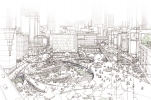Transit Oriented Development: Key Principles and Perspectives

According to World Bank case study on the integrated development of public transport and land use, most cities that are evaluated as sustainable develop their public transportation and land comprehensively. These cities have a long-term vision of what they should be in the future, and implement these plans through territorial zoning and the development of social infrastructure, which is reflected in the Transit Oriented Development (TOD). The achievement of these goals is based on five basic principles.
1. Green Transport Modes
Need to curb the automobile inflows to the area around the station, and encourage the use of public transportation through the development of so-called green transportation infrastructure, such as railways, Light Rail Transit (LRT), convenient places for boarding and disembarking passengers, and smart mobility. This will promote the improvement of the attractiveness of the area, the formation of a bustle centered on the station, and the formation of a rich pedestrian space. By concentrating development on the nearest station, it is possible to create a community that is not overly dependent on automobile traffic, and realize the formation of a low-carbon, public-transportation-centered city.
2. Walkable Network
The railway, station facilities, and road infrastructure are integrated to form an easy-to-understand and comfortable pedestrian network. The multi-layered pedestrian space that is tailored to the topography and functional accumulation becomes a wide-area network that connects the station and the city. By placing the vertical axis space that connects these in various places in the peripheral area of the station, it is possible to create a space where people rest and gather, not just for the purpose of movement, as a gateway to the town, and to form a highly migratory city.
 Materials provided by Nikken Sekkei
Materials provided by Nikken Sekkei
Full content of this issue you can read here
The full version of the article can be read in our printed issue, also you can subscribe to the web-version of the magazine


